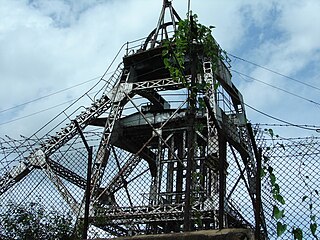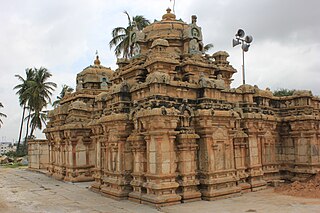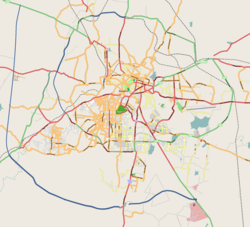
Domlur is a small township located in the eastern part of Bangalore city in India. Domlur was included in the erstwhile Bangalore Civil and Military Station under the British Madras Presidency till it was transferred to the Mysore State in 1949.

Kempe Gowda I, locally venerated as Nadaprabhu Kempe Gowda, or commonly known as Kempe Gowda, was a chieftain under the Vijayanagara Empire in early-modern India. He is famous for the development of Bangalore Town in the 16th century. He wrote Ganga-gauri-vilasa, a yakshagana (verse-play) in Telugu.

Kolar Gold Fields (K.G.F.) is a mining region in K.G.F. taluk (township), Kolar district, Karnataka, India. It is headquartered in Robertsonpet, where employees of Bharat Gold Mines Limited (BGML) and BEML Limited and their families live. K.G.F. is about 30 kilometres (19 mi) from Kolar, 100 kilometres (62 mi) from Bengaluru, capital of Karnataka. Over a century, the town has been known for gold mining. The mine closed on 28 February 2001 due to a fall in gold prices, despite gold still being present there. One of India's first power-generation units was built in 1889 to support mining operations. The mine complex hosted some particle physics experiments between the 1960s and 1992.

Bangalore is the capital city of the state of Karnataka. Bangalore, as a city, was founded by Kempe Gowda I, who built a mud fort at the site in 1537. But the earliest evidence for the existence of a place called Bangalore dates back to c. 890.

Yelahanka is a suburb and Taluk of Bangalore Urban district in the Indian state of Karnataka. One of the zones of BBMP. It is the oldest part of present Municipal Bengaluru (Bangalore) city and is in the north of the city. It is Nadaprabhu Kempegowda I, of the Yelahanka Prabhu clans, who laid the foundation of present-day Bengaluru through the creation of a "mud fort town" in 1537 CE

Western Ganga was an important ruling dynasty of ancient Karnataka in India which lasted from about 350 to 1000 CE. They are known as "Western Gangas" to distinguish them from the Eastern Gangas who in later centuries ruled over Kalinga. The general belief is that the Western Gangas began their rule during a time when multiple native clans asserted their freedom due to the weakening of the Pallava empire in South India, a geo-political event sometimes attributed to the southern conquests of Samudra Gupta. The Western Ganga sovereignty lasted from about 350 to 550 CE, initially ruling from Kolar and later, moving their capital to Talakadu on the banks of the Kaveri River in modern Mysore district.

Kengeri is a suburb in Bangalore city. It is located on the western corridor along Mysore Road, bordered by Nagarbhavi to the north,Rajarajeshwari Nagar to the east and Uttarahalli to the south.

Shri Dharmaraya Swamy Temple is one of the oldest and most famous Hindu temples of the city of Bangalore, in Karnataka, India.
Bangalore (Bengaluru), the capital of Karnataka state, India, reflects its multireligious and cosmopolitan character by its more than 1000 temples, 400 mosques, 100 churches, 40 Jain derasars, three Sikh gurdwaras, two Buddhist viharas and one Parsi fire temple located in an area of 741 km2 of the metropolis. The religious places are further represented to include the few members of the Jewish community who are making their presence known through the Chabad that they propose to establish in Bengaluru and the fairly large number of the Baháʼí Faith whose presence is registered with a society called the Baháʼí Centre. In the demographically diverse, major economic hub and India's fastest-growing major metropolis of Bengaluru, the number of religious places of each religion reported reflects growth in proportion to the population growth. According to the 2001 census of India, 79.37% of Bangalore's population is Hindu, roughly the same as the national average. Muslims comprise 13.37% of the population, which again is roughly the same as the national average, while Christians and Jains account for 5.79% and 1.05% of the population, respectively, double that of their national averages. Anglo-Indians also form a substantial group within the city.

Kadugodi is a suburb located in Whitefield, Bangalore in the state of Karnataka, India. The area is said to have been founded over 1000 years ago by the Chola dynasty.

The Nageshvara temple complex is located in Begur, a small town within the Bangalore urban district of Karnataka state, India. From inscriptions, it is known that Begur was once called Veppur, and Kelele. Two shrines within the temple complex, the Nageshvara and Nageshvarasvami were commissioned during the rule of Western Ganga Dynasty Kings Nitimarga I and Ereyappa Nitimarga II. The remaining shrines are considered a later day legacy of the rule of the Chola Dynasty over the region. An Old Kannada inscription, dated c. 890, that describes a "Bengaluru war" was discovered in this temple complex by the epigraphist R. Narasimhachar. The inscription is recorded in "Epigraphia Carnatica". This is the earliest evidence of the existence of a place called Bengaluru.
Old Madiwala Sri Someshwara Temple located in Bangalore city, Karnataka, India is dedicated to the deity Someshwara. It is one among the oldest temples in the city and dates back to the Chola Empire period. The temple belongs to the early 12th century.(1247 AD).

Bangalore, officially Bengaluru, is the capital and largest city of the southern Indian state of Karnataka. It has a population of more than 8 million and a metropolitan population of around 11 million, making it the third most populous city and fifth most populous urban agglomeration in India, as well as second largest urban agglomeration in South India, and the 27th largest city in the world. Located on the Deccan Plateau, at a height of over 900 m (3,000 ft) above sea level, Bangalore has a pleasant climate throughout the year, with its parks and green spaces earning it the reputation as the "Garden City" of India. Its elevation is the highest among the major cities of India.
There are nearly a thousand inscriptions in Tamil in the Southern Karnataka districts of Bangalore, Mysore, Kolar and Mandya in India. Nearly one third of these inscriptions are found in the Kolar District. Of all the inscriptions collected and published in the Epigraphia Carnatica Vol X for Kolar district, a fourth are in Tamil. The Tamil inscriptions start to appear around 1000 AD, after the conquest of the region by the Chola dynasty king Rajaraja I. Even after the Cholas left the area, the Hoysala and later the Vijaynagar kingdoms continued to use Tamil in the inscriptions.

Kalasipalya is a locality in the central part of Bangalore, Karnataka, India, and one of the older and most congested places in the city. The locality is home to landmarks such as Bangalore Fort and Tipu Sultan's Summer Palace. The area is known for its high traffic congestion and unhygienic conditions of roads.
Transport in Bangalore consists of several intracity commute modes such as BMTC buses, Namma Metro rail services, taxis and auto rickshaws, as well as several intercity forms of transport: Government operated KSRTC, NWKRTC, KKRTC, other states RTC buses, Private bus operators, trains, and flights.
Akshay Nagar is a neighbourhood in Begur ward in South Bangalore. It is surrounded by Hulimavu to the west and Begur to the east. The area has undergone rapid residential and commercial development since the early 2010s, including several high-rise apartment complexes. The locality is in close proximity to the Bannerghatta National Park, thus leading to occasional sightings of wild animals from the forest reserve. The area has a lake spread over 5 acres.













